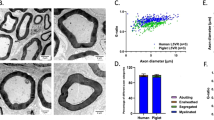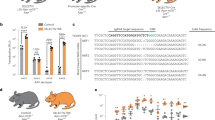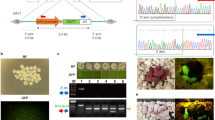Abstract
We have developed a micro-injection technique to deliver recombinant adenovirus and AAV to mouse fetuses at day 15 after conception. Several routes of delivery, including injections to the amniotic fluid, the front limb, the placenta, the liver, and the retro-orbital venus plexus, were tested using an E1-deleted recombinant adenovirus (Ad.CBlacZ) or a recombinant adeno-associated virus (AAV.CMVlacZ) carrying a β-galactosidase (lacZ) gene. Injection of Ad.CBlacZ into the amniotic cavity led to transgene expression in the skin and in the digestive tract of the fetuses. Injection of Ad.CBlacZ in the front limb resulted in LacZ expression in all major muscle groups around the injection site and at low levels in the liver. The other three routes of delivery, ie intra-placental, intra-hepatic and retro-orbital injections of Ad.CBlacZ, all led to lacZ expression predominantly in the liver. Further studies revealed a maximal tolerant dose (defined as the highest viral dose with ⩽20% mortality in the injected fetuses) of 1 × 109 particles per fetus for intra- hepatic injections, 3 × 109 particles per fetus for intra-placental injection, 1 × 1010 particles per fetus for retro-orbital and intra-amniotic injections, and 2 × 1010 particle per fetus for intra-muscular injection. The adenovirus-mediated lacZ expression in liver and muscle persisted for at least 6 weeks. Intra-muscular injection of AAV.CMVlacZ also resulted in lacZ expression in the muscle up to 3 months after birth with no indication of cellular immune response at the injection site. Taken together, our results demonstrated that prolonged transgene expression can be achieved by in utero gene transfer using either adenoviral or AAV vectors. The distribution of virus-mediated gene transfer appeared to determined mostly by the route of viral administration.
This is a preview of subscription content, access via your institution
Access options
Subscribe to this journal
Receive 12 print issues and online access
$259.00 per year
only $21.58 per issue
Buy this article
- Purchase on Springer Link
- Instant access to full article PDF
Prices may be subject to local taxes which are calculated during checkout






Similar content being viewed by others
References
Pitt B et al. Retrovirus-mediated gene transfer in lungs of living fetal sheep Gene Therapy 1995 2: 344–350
Turkay A, Saunders T, Kurachi K . Intrauterine gene transfer: gestational stage-specific gene delivery in mice Gene Therapy 1999 6: 1685–1694
Porada C et al. In utero gene therapy: transfer and long-term expression of the bacterial neo(r) gene in sheep after direct injection of retroviral vectors into preimmune fetuses Hum Gene Ther 1998 9: 1571–1585
Douar A, Themis M, Coutelle C . Fetal somatic gene therapy Mol Hum Reprod 1996 2: 633–641
Vincent M et al. Adenovirus-mediated gene transfer to the respiratory tract of fetal sheep in utero Hum Gene Ther 1995 6: 1019–1028
McCray P et al. Adenoviral mediated gene transfer to fetal pulmonary epithelia in vitro and in vivo J Clin Invest 1995 95: 2620–2632
Sekhon H, Larson J . In utero gene transfer into the pulmonary epithelium Nature Med 1995 1: 1201–1203
Holzinger A et al. Intraamniotic administration of an adenoviral vector for gene transfer to fetal sheep and mouse tissues Pediatr Res 1995 38: 844–850
Larson J et al. Reversal of cystic fibrosis phenotype in mice by gene therapy in utero Lancet 1997 349: 619–620
Baldwin H, Mickanin C, Buck C . Adenovirus-mediated gene transfer during initial organogenesis in the mammalian embryo is promoter-dependent and tissue-specific Gene Therapy 1997 4: 1142–1149
Cohen J et al. Molecular pathophysiology of cystic fibrosis based on the rescued knockout mouse model Mol Genet Metab 1998 64: 108–118
Wang G et al. Ultrasound-guided gene transfer to hepatocytes in utero Fetal Diagn Ther 1998 13: 197–205
Schachtner S et al. Temporally regulated expression patterns following in utero adenovirus-mediated gene transfer Gene Therapy 1999 6: 1249–1257
Lipshutz G et al. Short-term correction of factor VIII deficiency in a murine model of hemophilia A after delivery of adenovirus murine factor VIII in utero Proc Natl Acad Sci USA 1999 96: 13324–13329
Lipshutz G, Flebbe-Rehwaldt L, Gaensler K . Adenovirus-mediated gene transfer to the peritoneum and hepatic parenchyma of fetal mice in utero Surgery 1999 126: 171–177
Lipshut G, Flebbe-Rehwaldt L, Gaensler K . Adenovirus-mediated gene transfer in the midgestation fetal mouse J Surg Res 1999 84: 150–156
Yang EY et al. Persistent postnatal transgene expression in both muscle and liver after fetal injection of recombinant adenovirus J Pediatr Surg 1999 34: 766–772
Muzyczka N . Use of adeno-associated virus as a general transduction vector for mammalian cells Curr Top Microbiol Immunol 1992 158: 97–127
Kaufman M . The Atlas of Mouse Development Academic Press: San Diego, CA 1994
Solomon J . Ontogeny of defined immunity in mammals. In: Foetal and Neonatal Immunology. Neuberger A, Tatum E (eds) Elsevier: New York 1971 pp 234–306
Xiao W et al. Adeno-associated virus as a vector for liver-directed gene therapy J Virol 1998 72: 10222–10226
Kozarsky K, Grossman M, Wilson JM . Adenovirus-mediated correction of the genetic defect in hepatocytes from patients with familial hypercholesterolemia Somat Cell Mol Genet 1993 19: 449–458
Xiao WD et al. Gene therapy vectors based on adeno-associated virus type I J Virol 1999 73: 3994–4003
Acknowledgements
This work was supported by the NICHD PO1-HD32649 (to MLB and XY).
Author information
Authors and Affiliations
Rights and permissions
About this article
Cite this article
Mitchell, M., Jerebtsova, M., Batshaw, M. et al. Long-term gene transfer to mouse fetuses with recombinant adenovirus and adeno-associated virus (AAV) vectors. Gene Ther 7, 1986–1992 (2000). https://doi.org/10.1038/sj.gt.3301332
Received:
Accepted:
Published:
Issue Date:
DOI: https://doi.org/10.1038/sj.gt.3301332
Keywords
This article is cited by
-
Augmentation of transgene-encoded protein after neonatal injection of adeno-associated virus improves hepatic copy number without immune responses
Pediatric Research (2015)
-
Intra-Amniotic rAAV-Mediated Microdystrophin Gene Transfer Improves Canine X-Linked Muscular Dystrophy and May Induce Immune Tolerance
Molecular Therapy (2015)
-
Kidney-specific expression of GFP by in-utero delivery of pseudotyped adeno-associated virus 9
Molecular Therapy - Methods & Clinical Development (2014)
-
The developmental stage determines the distribution and duration of gene expression after early intra-amniotic gene transfer using lentiviral vectors
Gene Therapy (2010)
-
Efficient Gene Transfer Into the Mouse Lung by Fetal Intratracheal Injection of rAAV2/6.2
Molecular Therapy (2010)



